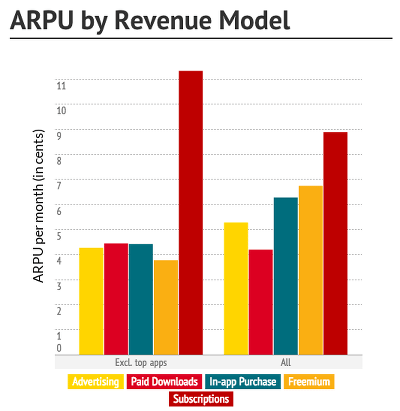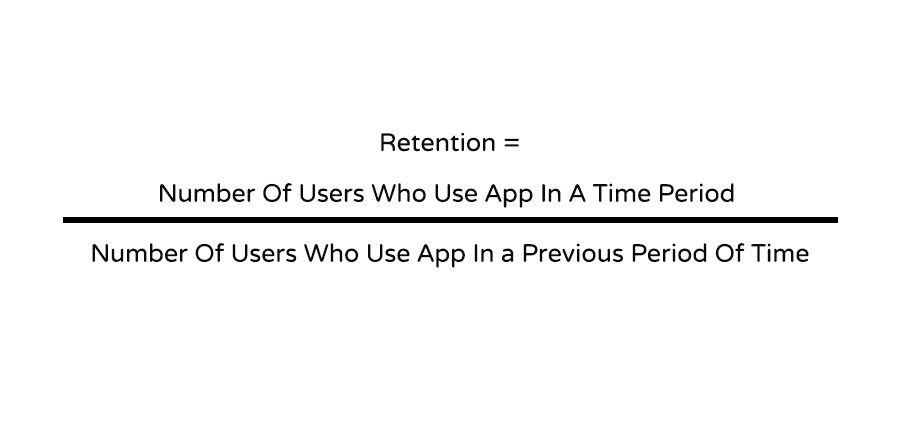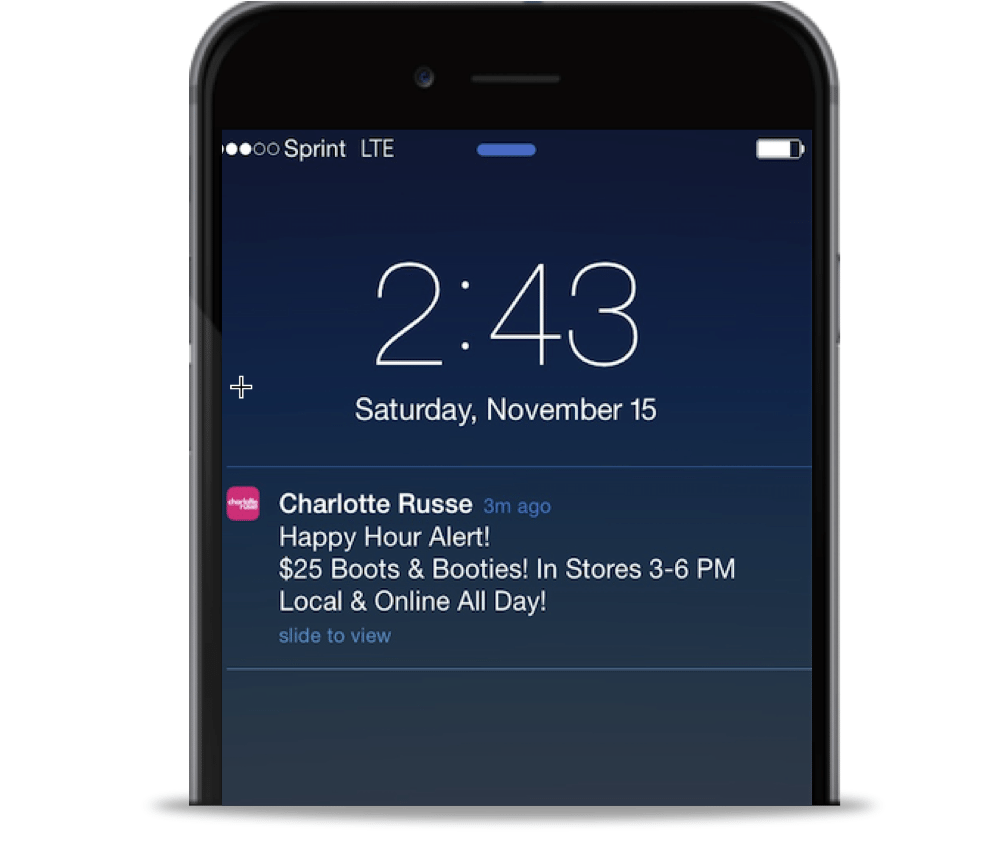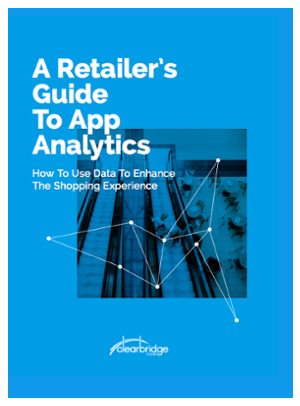User Lifetime Value (LTV) is the measure of a user’s value over a period of time. LTV is one of the most important mobile app metrics to track because it will help you reevaluate your acquisition strategy and estimate marketing costs based on the profitability of your app.
There are several factors that influence LTV such as app referrals or the revenue for ads and in-app purchases. Even if a user doesn’t spend money on in-app purchases for example, they may still be valuable if they shared your app with a friend. For this reason, LTV is a much more complex metric to track than simply measuring the average revenue per user (ARPU). This metric provides insight on what stage of the user lifecycle users bring the most value. You’ll be able to use LTV data to optimize marketing campaigns in order to target high-value users.
Leveraging LTV
Apps that perform well in the app market can make millions of dollars, but most fail to even turn a profit. A key difference is that app marketers that launch successful apps understand the value of each user. Gathering this data will help you focus in on enhancing specific areas where users provide the most value. For example, if you’re seeing that virality is low, try integrating social buttons within your app to encourage users to easily share it with their friends.
In our last post, we discussed the key mobile app metrics you should be tracking to boost performance. We stated that LTV is arguably one of the most important metrics to measure. Now, we’ll provide a breakdown of the parts that make up this broad metric and recommend tactics for LTV augmentation.
How to Calculate LTV
It’s important to note that LTV does not include the entire user base, but focuses on different segments and cohorts to analyze different patterns of behavior. Measuring LTV however, is much more complicated than merely calculating the ARPU. 3 main factors that influence LTV are retention, monetization, and virality. ARPU, and ARPDAU (average revenue per daily active user) also play an influential role in LTV and should not be overlooked.
Retention:
How often do your users engage with your app? How many repeat users? Retention rate is the level of engagement a customer has with your app over the length of the average customer lifecycle. In calculating retention, you’ll need to measure how often users return to your app after the initial installation.
Monetization:
Determine how much money a user spends on the app whether it’s from ad impressions, subscriptions, or in-app purchases.
Virality:
Virality is the total value of potential users that your current users refer the app to. These referrals can be brought in via social media, word-of-mouth, and so on.
ARPU:
This is the revenue that is calculated by dividing total revenue by the total number of users.
Source: Apptentive
ARPDAU:
This metric is calculated by dividing the Average Revenue Per User by Daily Active Users.
3 Methods to Calculate LTV
There are a number of methods to calculate LTV depending on the category of the app and the metrics that are available:
Tapdaq’s Approach:
Tapdaq’s approach uses the churn rate, which is the percentage of users that stop using the app over a period of time:
Average LTV:
This method is better used when you have a larger user base that spends a lot of money on your app:
Weekly Cohort:
Includes In-App Purchase Revenue and segments of users based on a particular week. In using this method, you should segment users into groups based on the week of the year in which they download the app for best results.
Calculating the LTV of a mobile app is an all-encompassing process that requires many different metrics. Appboy provides an in-depth breakdown of the key mobile app metrics to measure to help you determine your LTV formula.
Now that we’ve covered the 3 basic methods to calculate LTV, there are certain tactics you should use to heighten the value of your users:
8 Tactics to Boost LTV
To yield high ROI rates of your marketing campaigns, you have to maximize the lifetime value of users by ultimately boosting app usage. Here are 8 methods that will help you keep your user’s engaged, spending money, and spreading the word about your app:
-
Mobile Deep Linking
Mobile deep linking is the process of using a URL to link to specific pages or locations within a mobile application. It can be used in a variety of ways, such as notifications, email, SMS, social media, etc. and directs users to relevant content. Deep Linking is seen as a shortcut between user awareness and the conversion stage.
-
Optimize Your User Onboarding Process
The onboarding experience needs to be simple and personalized, impressing users right from the start in order to gain retention. Testing different onboarding flows will help you better understand how users are onboarding. To optimize your user onboarding process, you can reduce sign up/login fields, provide users with assistance logging in, and offer a tutorial on how to use the app.
-
Use Push Notifications Wisely
The more users you can get to opt-in to push notifications, the greater the ability to leverage notifications to encourage in-app interactions and re-engage inactive users. However, there’s a fine line between enhancing the user experience and being too intrusive with push notifications. Cross this line, and you’ll do exactly the opposite – deterring users from using the app. Segment your users and make sure your push notifications are personalized in order to increase engagement rates.
-
Continuously Improve Your User Acquisition Strategy
Don’t forget that you need to continuously reevaluate and optimize your user acquisition strategy in order to maximize your users’ lifetime value. Uncover gaps in your strategy and determine how to solve them.
-
Make User-Centered Decisions
To attain high LTV, you need to make user-centered decisions throughout the entire product lifecycle. Be aware of user needs and desires and try to make the best possible app to serve their needs. Offer support on a variety of channels such as Facebook or Twitter. Further, integrating an in-app support tool will also prove to be beneficial by enhancing the UX which will boost engagement.
-
Encourage Word-of-Mouth
Social platforms are great tools for more than just user feedback. They are excellent platforms for users to spread the word about your app by sharing their experiences. Social sharing is particularly important for media apps where the more content is shared, the more users it will attract. Social isn’t just a channel for marketing your app but should also be used as a user acquisition tool. Integrate sharing buttons into your app so users can easily promote pages, content, and products.
-
Run Targeted Marketing Campaigns
Running targeted marketing campaigns for current users will also establish greater user engagement rates, which will help increase LTV. Run push messaging campaigns to re-engage users who are inactive and remind those who haven’t opened your app in a while, or notify them of important updates. Run in-app messaging campaigns to direct users to your app or provide personalized offers to keep them coming back.
-
Improve UI
If your mobile app UI design makes it impossible for users to access certain features, users will get frustrated and drop off. Using analytics to understand friction points will allow you to create a much more seamless and engaging experience that will boost usage and session length.
Despite which tactics you choose to boost user LTV, there’s always one goal to keep in mind – to maximize user satisfaction. Skip this and user drop off rates will skyrocket while LTV suffers the consequences.
Using LTV to Tweak Your User Acquisition Strategy
To maximize revenue, you must target and acquire high-value users. Without reevaluating your UAS, you won’t be able to determine if you are paying too much money to acquire users. LTV is dependent on your customer acquisition cost so you want to ensure that your acquisition costs are decreasing over time while your user LTV is increasing. You should constantly be tweaking your UAS by identifying which acquisition sources or campaigns are bringing in the highest value users. With this understanding, you can optimize your campaigns and advertising spend to focus your resources only on the sources and campaigns bringing in the most valuable users.
There’s No Industry-Standard LTV Calculation
With the varying approaches to LTV, there’s one component that remains consistent across all formulas – the reliance on post-install data (retention, virality, and monetization). Whichever formula of calculating LTV you choose, make sure that you stick to a single method for consistent and accurate results.
These LTV formulas will help you assess whether you’re paying too much for your customers, depending on the value they provide your company. When you’re dealing with financial planning, calculating the ARPU alone is too simple to base decisions on. For accurate results, you’ll need an all-encompassing metric to get the bigger picture.

















